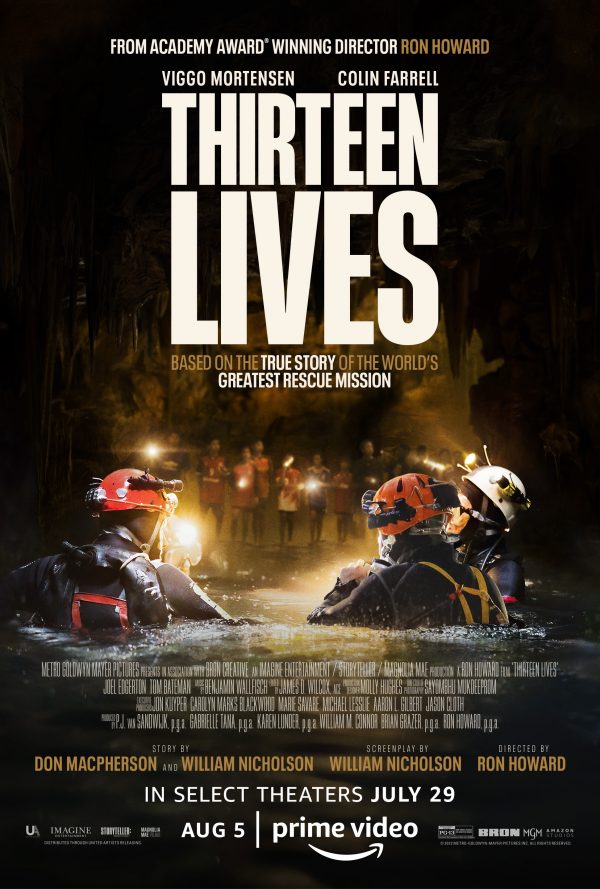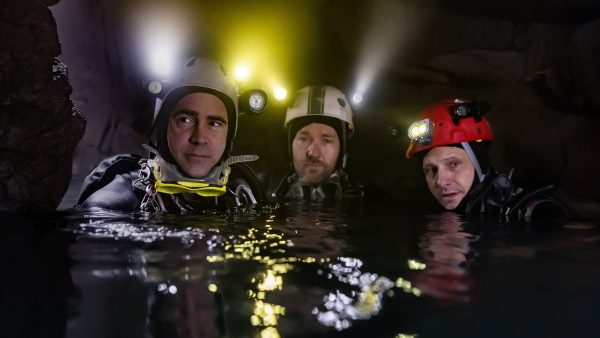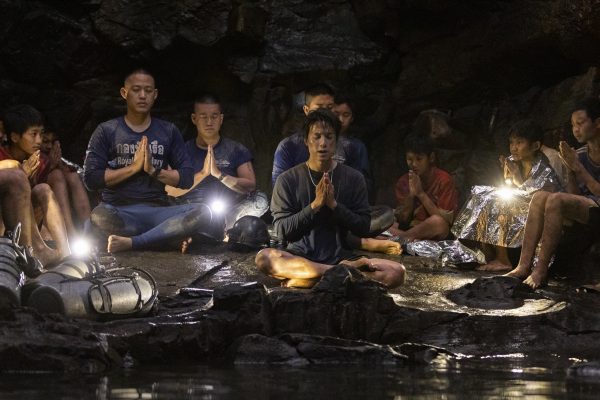‘Thirteen Lives’ celebrates the virtues of collaboration

“Thirteen Lives” (2022). Cast: Viggo Mortensen, Colin Farrell, Joel Edgerton, Tom Bateman, Paul Gleeson, Sahajak “Poo” Boonthanakit, Tui Theerapat Sajakul, Weir Sukullawat Kanaros, Thira Chutikul, James Teeradon Supapunpinyo, Lewis Fitz-Gerald, Peter Knight, Popetorn “Two” Soonthornyanakij, Pattrakorn Tungsupakul, Aom-Sin Pasakorn, Achi Jinapanyo, Smart Tanatat. Director: Ron Howard. Screenplay: William Nicholson. Story: Don MacPherson and William Nicholson. Web site. Trailer.
It’s quite something when an event happens that captures the world’s attention. Unfortunately, it usually involves some form of natural or manmade disaster or the death of a prominent figure. But then there are times when occurrences take place that collectively captivate us, bringing out the compassion and humanity in us all and frequently producing miraculous results. These events embody the best in all of us, showing that we are indeed capable of great things when we put our hearts, minds and efforts to it, a scenario heroically depicted in the new fact-based historical re-creation, “Thirteen Lives.”
For 18 days during the summer of 2018, the world’s attention was focused on the attempted rescue of 12 young soccer players and their coach (James Teeradon Supapunpinyo) who were trapped inside the flooded Tham Luang Nang Non cavern in northern Thailand’s Chiang Rai province. An unexpected monsoonal rainstorm moved in over the mountain towering over the cave, enabling huge volumes of water to percolate downward through crevices and sinkholes, quickly inundating the channels and chambers of the long, deep cavern system. Given that the storm occurred before the typical start of monsoon season, it took everyone by surprise, forcing the intrepid young cave explorers to hastily flee in search of safety. However, for much of the time after the flooding initially began, no one knew for certain what fate befell the missing.
Rescuers flocked to the cave to try and figure out what to do. Considering the hazardous conditions in the narrow flooded corridors, it wasn’t clear if even experienced cave divers could make their way through the tight passageways. And, in light of that, authorities overseeing the project weren’t sure they could sanction such ventures given the danger involved, especially with no guarantee of finding anyone still alive. Even expert responders like Thailand’s Navy SEALs were unsure if they’d be tapped for such a treacherous mission.
As officials contemplated how they might reach the survivors (if any), they undertook efforts to stem the tide of the flooding, such as looking for ways to divert the flow of rainwater off the mountain so it wouldn’t penetrate the crevices and worsen conditions inside the cave below. It was believed this measure might increase the survival chances of the missing, but diverting the flow would come at a cost: It would flood adjacent agricultural fields and wipe out the rice crops of peasant farmers. However, considering what was at stake, the farmers willingly agreed to the plan if it might help the boys and their coach, despite the uncertainty of their fate. That’s because, as their story spread, the missing 13 were increasingly being seen as the responsibility of everyone in Thailand, not just those actively working on their possible rescue.

Despite efforts like those aimed at redirecting the flow of rainwater, officials were concerned about other issues, such as the availability of oxygen inside the cave. Even if the team had somehow managed to survive, it was unclear whether or not they would have enough breathable air, considering that every breath they took would lead to the release of carbon dioxide and dilute the available oxygen level. With the clock ticking, authorities realized that they had to intensify their efforts before time ran out.
This intensification led to a ramping up of efforts on multiple fronts, with volunteers pouring in from all over. Volunteer ranks estimated at 10,000, made up of specialists and everyday individuals, from 17 countries took part, all with one goal in mind – saving the boys and their coach, if at all possible, at virtually any cost.
Spearheading this intensified effort were expert cave divers, led by Rick Stanton (Viggo Mortensen) and John Volanthen (Colin Farrell) from the UK. Nine days after the 13 went missing, Stanton and Volanthen succeeded in finding them deep inside the cavern in a chamber where they had been holed up on an internal “beach,” located approximately 2.5 miles from the cave mouth. Needless to say, the divers were stunned and grateful to find everyone still alive. But the next question became, “How do we get them out?”
The elation of finding everyone alive quickly dissolved when authorities and divers assessed the logistics of rescuing the trapped youngsters. The thought of trying to guide untrained youthful divers through the narrow passageways for a distance of 2.5 miles was daunting. In addition to the boys’ lack of diving skills, rescuers were also concerned about them being able to remain calm for such an untested long-distance “swim.” But, considering the alternative – everyone inevitably suffocating from a lack of oxygen or drowning from new flooding if nothing were done in time – it seemed wholly unconscionable to willingly abandon them, leaving them to die knowing that they were indeed alive before that was allowed to happen. So what were the rescuers to do?

Stanton and Volanthen reviewed various options, though all of them were considered unfeasible. But then they came up with a brainstorm that could be a possible breakthrough. They proposed seeking the assistance of Dr. Richard “Harry” Harris (Joel Edgerton), an Australian cave diver and practicing anesthesiologist. Stanton and Volanthen recommended a novel but exceedingly risky plan for retrieving the boys and their coach. It was a proposal that not only posed tremendous risks for the youngsters, but also the divers. It also raised ethical issues that Dr. Harris initially found entirely unacceptable. However, with no other viable alternatives available, a dwindling time window and the threat of more rain with the official arrival of monsoon season, the rescue team had to act – and quickly – if it were to carry out the plan.
The mission proved to be an effort mixed with the miraculous and the tragic, but it brought people together in ways no one had likely imagined possible. And its impact was felt not only by those directly involved in the effort, but also by those who lent their thoughts, prayers and energy to the success of the operation. It was a venture that stirred the world, touching individuals around the globe, reaching far outside the borders of Thailand. But, perhaps most importantly, it illustrated what’s possible when we all work toward a common goal, no matter what the capacity, one that brings out the best in us and shows what we can do if we collaborate and put our minds together.
If only we as a species could cooperate and collaborate with one another like this all the time, we’d have much more about ourselves to be proud of! The effort that went into this rescue truly illustrates the notion of the total being greater than the sum of its parts. In an age when callousness and indifference are all too often allowed to determine the course of events (and all of the “collateral damage” that comes with them), it’s heartening to see we’re still capable of mounting a Herculean effort to save the lives of 13 people, a number that, sadly, might otherwise be readily written off as inconsequential or not worth the risk.
So what makes this scenario different? The beliefs that went into its execution made all the difference. The underlying sense of compassion alone significantly drove the effort to carry on in the face of seemingly impossible odds. But, more than that, a sincere belief in attaining success in this endeavor made it happen thanks to the conscious creation process, the philosophy that maintains we manifest the reality we experience through the power of these intangible resources. It’s not clear how many of those involved in this venture had heard of this school of thought, but, based on the results achieved, it’s obvious that its participants believed in the viability of its principles and subsequently made them work.

There’s much to be said for the power of belief, even if one doesn’t use this particular term to describe what was involved here. Call it prayer or invocation or supplication or intent or whatever other word best suits you for describing the means to achieve the desired outcome. At bottom, these notions all essentially stem from the same source of origin – what we hold in our hearts and minds for arriving at the intended destination. And, based on what unfolded, there’s pretty powerful evidence to indicate that it genuinely works, despite the seemingly insurmountable conditions here that might have made such results seem impossible.
To a great degree, the overarching perspectives that participants hold regarding such an undertaking play a significant role in the process as it plays out. In many ways, this scenario draws heavily from the notion of determining whether the glass is half empty or half full. Those who held fast to the former perspective could very well have undermined the outcome. Meanwhile, those who remained open and steadfastly held on to options, hope and the materialization of a breakthrough solution saw their convictions and beliefs realized. Again, there’s much to be said for the power behind these intangible tools and what they can enable.
The specific beliefs constituting this perspective, of course, played a key role in the course of events. Paramount among these notions were the faith and trust that participants placed in achieving a successful outcome. In fact, they essentially served as the foundation of this effort, one whose success likely wouldn’t have been attained without them.
At the same time, the noticeable lack of certain other beliefs was crucial as well. By excluding or minimizing beliefs related to fear, doubt and limitation, the rescuers were able to keep such influences at bay in terms of any impact they might have had on the process. This is not to say these elements were totally absent, as evidenced by the occurrence of one notable tragedy that took place during the implementation of the rescue team’s plan. However, in the greater scheme of things, considering what everyone was up against, the fact that these undue influences were prevented from having a greater impact is indeed remarkable.
Of course, none of this could have happened without the aforementioned spirit of cooperation and collaboration. This included everyone who played a part in this multifaceted heroic co-creation. There were the divers, the rain-diverting engineers and their support teams, whose hands-on efforts made the plan work. Then there were the countless individuals who prayed for a successful outcome, both on their own and in organized vigils, around the globe. And, needless to say, there were the trapped victims themselves, who found a way to safety and managed to stay alive for a seemingly interminable length of time, doing their part to make the efforts of the others worth their time, energy and heroism.

Perspective played a significant role in this, too, most notably where the coach was involved. Having acted as chaperone for the boys in their cave exploration, he felt personally responsible for their well-being. During their time in the cave, he went to great lengths to keep them alive, such as leading them in meditation to keep them calm and to help them regulate their breathing to avoid using up precious oxygen. On top of that, he unknowingly benefitted from the intangible support of those who prayed for the missing; while he was worried that he’d be blamed for the circumstances in which the youngsters found themselves, he was instead praised for his efforts at helping to keep them alive at a time when they might have just as easily perished. This is more proof of the power of beliefs at work and what they can yield for the benefit of all concerned.
Taken collectively, the elements that made for a positive outcome truly represent a remarkable example of what we can achieve when we draw upon the power of properly formulated beliefs and what’s possible when their strength is combined. We should follow that lead and sincerely make an effort to employ such measures on an ongoing basis if we hope to make this the world many of us hope it can be. This is just one such illustration of what’s possible when we do that. Maybe we should all heed the message in this – and consciously make the effort to put it to use regularly.
This inspiring story truly moved people around the globe, and director Ron Howard has brought it to life in a technically masterful re-creation. The level of logistical detail on display here is commendable in virtually every respect, frequently making for an edge-of-the-seat watch. However, as capably made as this picture is, its 2:29:00 runtime can occasionally try the patience of even the most committed viewers, even when the tension level is cranked up, especially in sequences where the action essentially becomes repetitive. This is by no means intended to diminish the uplifting nature of the story or the adeptness with which it has been produced cinematically, but, given the emphasis on the picture’s technical merits, this approach tends to shortchange the emotional impact somewhat. A journalistically styled by-the-numbers take on telling a story like this is fine, but I was hoping for something a little more heartfelt at times in light of the miracle this epically heroic real life yarn turned out to be. “Thirteen Lives” definitely earns a more than passing grade, but I can’t help but wonder what it might have been with the infusion of a little more emotion – and a lot more heart-tugging. The film played briefly in theaters and is now available for streaming online.
Enlightening stories like this genuinely deserve wider attention and recognition in the current zeitgeist. If we were to become more aware of what we’re doing right as a species than being fed a diet of where we’re deficient, we just might change our overall perspective on life and what we’re capable of achieving. It would provide us with a new outlook and potentially a new set of beliefs for manifesting a better, more caring reality. It might even prompt us to see our existence as a glass that’s more than half full, one that’s brimming with possibilities in which we’d readily step up to participate as engaged members of the human collective. And what a world that would be.
Copyright © 2022, by Brent Marchant. All rights reserved.



